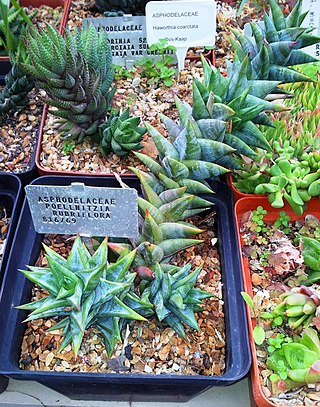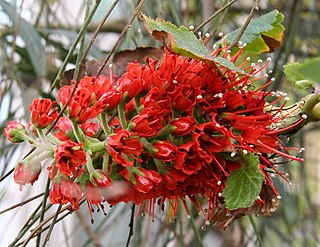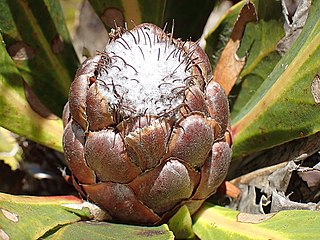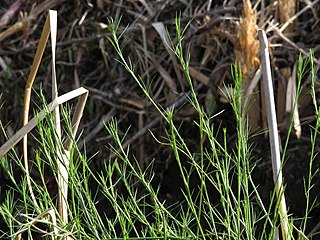
Leucadendron argenteum is an endangered plant species in the family Proteaceae, which is endemic to a small area of the Cape Peninsula, South Africa. Most grow in and around the city of Cape Town, but outlying populations exist near Somerset West (Silwerboomkloof), Paarl and Stellenbosch. It is a protected tree in South Africa.

Protea laurifolia, also known as the grey-leaf sugarbush, is a shrub from South Africa. It is native to the Cape Provinces of South Africa.

Psoralea arborea is a species of legume in the family Fabaceae. It is a shrub or tree endemic to the Cape Provinces of South Africa.

Umtiza is a monotypic genus in the legume family Fabaceae containing the single species Umtiza listeriana. This tree is endemic to a small coastal portion of the Eastern Cape in South Africa.

Greyia is a genus of plant in family Francoaceae. It contains three species:

Protea comptonii, also known as saddleback sugarbush, is a smallish tree of the genus Protea in the family Proteaceae. It is found in South Africa and Eswatini.

Burchellia is a monotypic genus of flowering plants in the family Rubiaceae. The genus contains only one species, viz. Burchellia bubalina, which is endemic to southern Africa: the Cape Provinces, KwaZulu-Natal and the Northern Provinces in South Africa, and Eswatini. It is commonly known as wild pomegranate (English) or wildegranaat (Afrikaans).

Astroloba rubriflora is a succulent plant found in the mountainous Karoo area around Robertson, South Africa. It is listed as a Vulnerable species on the IUCN global Red List.

Greyia sutherlandii, also known as Natal bottlebrush, is a species of plant in the Francoaceae family. It is native to South Africa, Eswatini, and Lesotho.
Natal bottlebrush is a common name for several plants and may refer to:

Greyia radlkoferi, the woolly bottlebrush or Natal bottlebrush, is a shrub or small tree, native to South Africa. It grows up to 5 metres in height and has smooth yellowish bark, becoming grey and deeply furrowed as it matures. The leaves are oval or heart-shaped and woolly on the undersurface, which distinguishes the species from Greyia sutherlandii. The scarlet flowers occur in dense, upright clusters from July to October in the species' native range.

Aloiampelos ciliaris, formerly Aloe ciliaris, the common climbing-aloe, is a thin, tough, rapidly growing succulent plant from South Africa.

Aloiampelos gracilis, formerly Aloe gracilis, the rocket aloe, is a succulent plant, endemic to dry thicket vegetation around the city of Port Elizabeth, South Africa. Its natural range lies just to the west of the related Aloiampelos ciliaris, and it occurs in bushy fynbos and dry thickets, and clustered on rocky outcrops at all altitudes. Its range extends westwards into the Baviaanskloof mountains.
Henry George Flanagan was a Cape Colony-born plant collector, traveller, botanist and farmer. He developed a renowned garden for native South African trees and rare exotic plants. A rare endemic of Eastern Cape, Greyia flanaganii is one of several plants named in his honour.
Oncocalyx quinquenervius is a parasitic plant species in the family Loranthaceae native to South Africa. It is also known as banded matchflower.

Protea vogtsiae, also known as the Kouga sugarbush, is a small flowering shrub of the genus Protea within the family Proteaceae, which is only found growing in the wild in the southern Cape Region of South Africa.

Protea convexa, also known as large-leaf sugarbush, is a rare flowering shrub in the genus Protea of the family Proteaceae, which is endemic to the southwestern Cape Region of South Africa.

Psoralea fascicularis, the large-stipule fountainbush, is a species in the pea or Fabaceae family. It is endemic to the Western Cape province of South Africa where it has been red listed as endangered (EN) by the International Union for Conservation of Nature (IUCN) Red List of Threatened Species due to its declining population.

Ornithoglossum undulatum, also known as the Karoo Slangkop, is a species of flowering plant in the family Colchicaceae. It is found in Southern Namibia and South Africa. In South Africa its range extends as far east as Somerset East in Eastern Cape Province. O. undulatum is a poisonous plant, and consumption of the leaves can kill livestock.

Serruria brownii, the bottlebrush spiderhead, is a flower-bearing shrub that belongs to the family Proteaceae and forms part of the fynbos. The plant is native to the Western Cape, South Africa.



















